Analysis of IAS 36 and Asset Impairment for Myer Holdings Limited
VerifiedAdded on 2020/02/24
|7
|1615
|57
Report
AI Summary
This report analyzes the asset impairment practices of Myer Holdings Limited, focusing on the application of IAS 36. The report details the process of determining asset impairment, including the division of assets into tangible and intangible categories, and the assessment of indicators suggesting impairment. It examines the methods used by Myer Holdings, such as the discounted cash flow model, to determine the recoverable amount of assets, particularly goodwill. The report highlights the importance of comparing the value in use with the recoverable amount to identify impairment losses. It also covers the data and information required for the impairment process, the role of both external and internal sources in gathering relevant information, and the flexibility of the management in analyzing the impairment of assets. The analysis concludes that the company effectively follows the procedures outlined in IAS 36 for asset impairment and advises continued adherence to these practices.
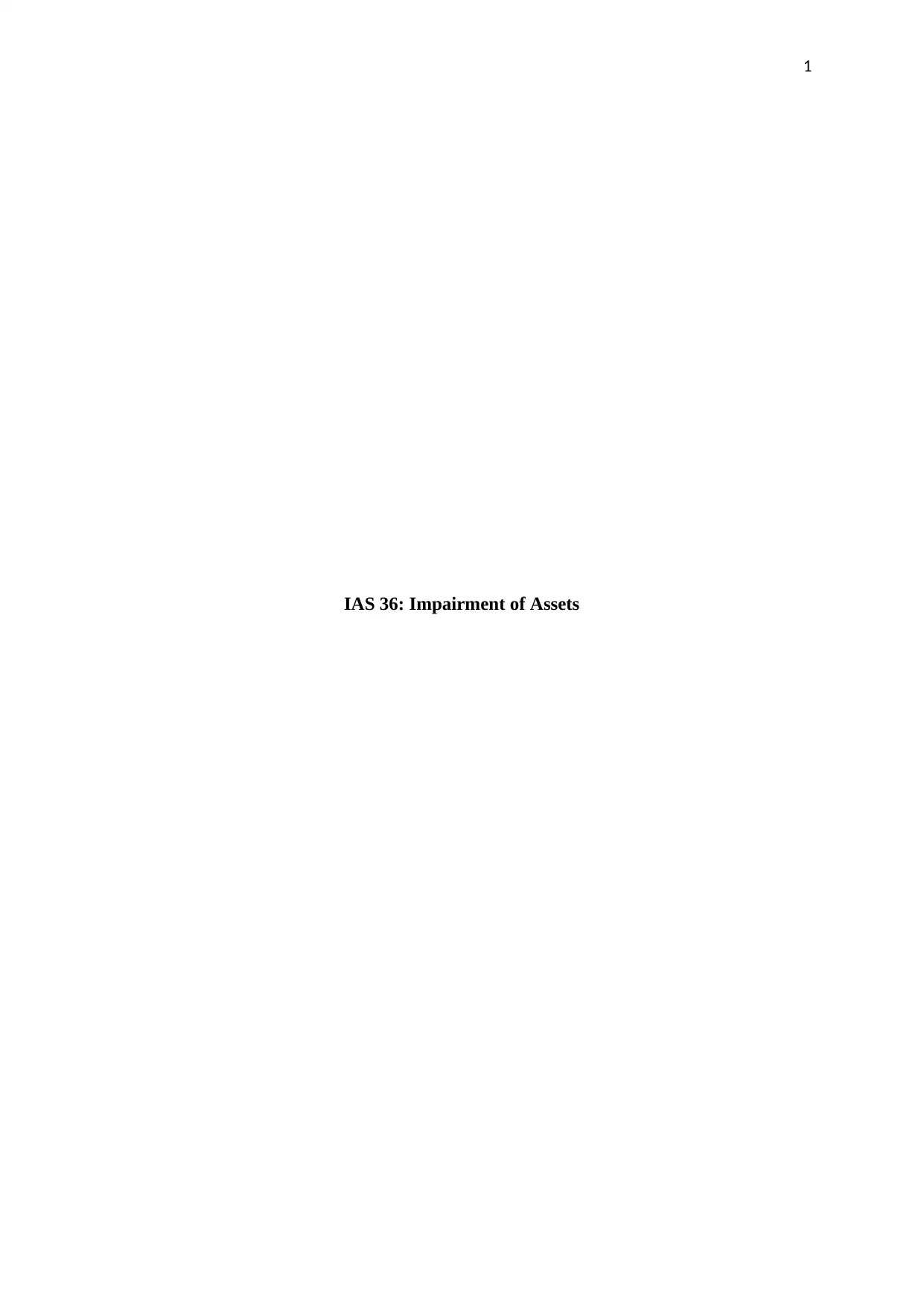
1
IAS 36: Impairment of Assets
IAS 36: Impairment of Assets
Paraphrase This Document
Need a fresh take? Get an instant paraphrase of this document with our AI Paraphraser
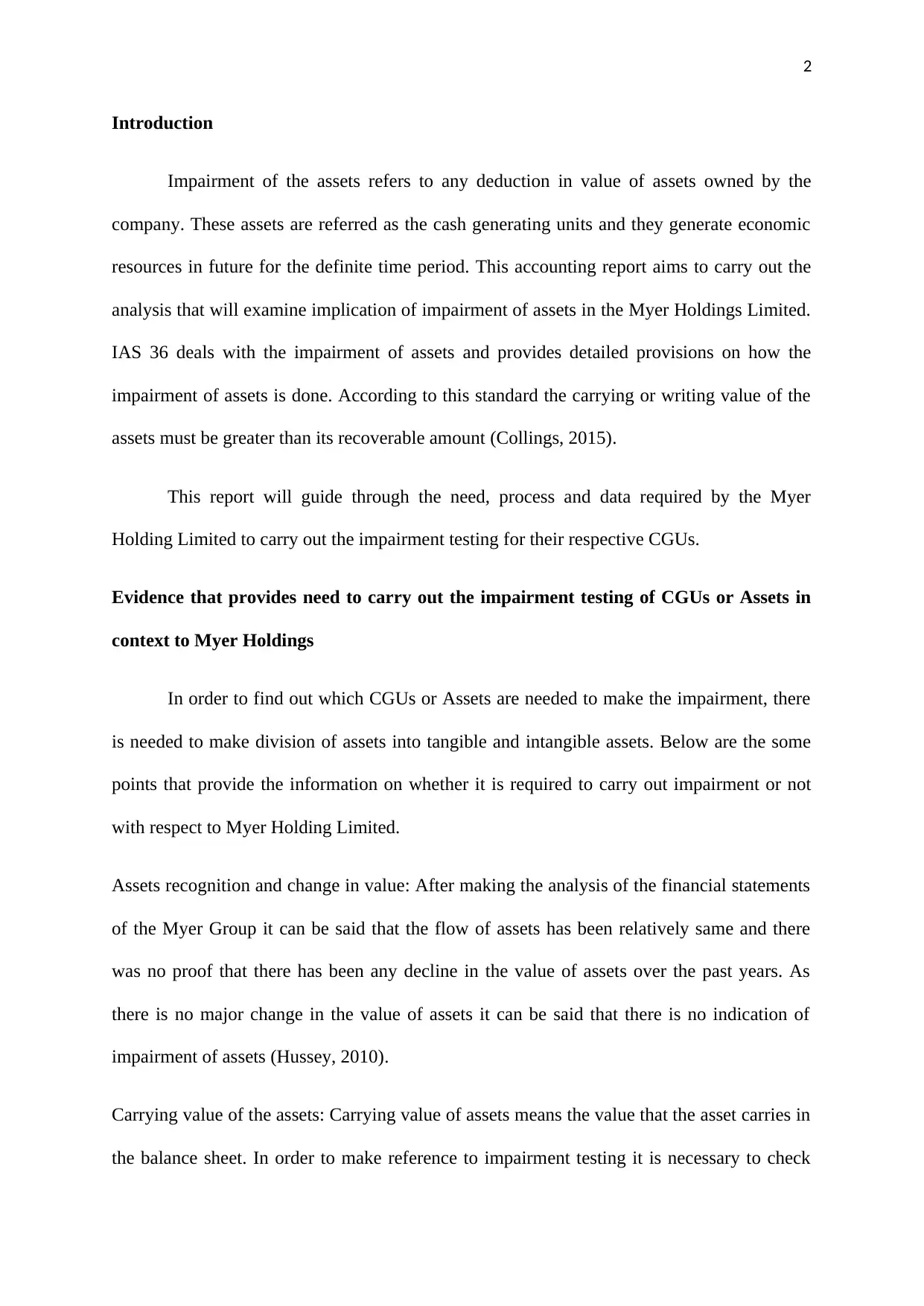
2
Introduction
Impairment of the assets refers to any deduction in value of assets owned by the
company. These assets are referred as the cash generating units and they generate economic
resources in future for the definite time period. This accounting report aims to carry out the
analysis that will examine implication of impairment of assets in the Myer Holdings Limited.
IAS 36 deals with the impairment of assets and provides detailed provisions on how the
impairment of assets is done. According to this standard the carrying or writing value of the
assets must be greater than its recoverable amount (Collings, 2015).
This report will guide through the need, process and data required by the Myer
Holding Limited to carry out the impairment testing for their respective CGUs.
Evidence that provides need to carry out the impairment testing of CGUs or Assets in
context to Myer Holdings
In order to find out which CGUs or Assets are needed to make the impairment, there
is needed to make division of assets into tangible and intangible assets. Below are the some
points that provide the information on whether it is required to carry out impairment or not
with respect to Myer Holding Limited.
Assets recognition and change in value: After making the analysis of the financial statements
of the Myer Group it can be said that the flow of assets has been relatively same and there
was no proof that there has been any decline in the value of assets over the past years. As
there is no major change in the value of assets it can be said that there is no indication of
impairment of assets (Hussey, 2010).
Carrying value of the assets: Carrying value of assets means the value that the asset carries in
the balance sheet. In order to make reference to impairment testing it is necessary to check
Introduction
Impairment of the assets refers to any deduction in value of assets owned by the
company. These assets are referred as the cash generating units and they generate economic
resources in future for the definite time period. This accounting report aims to carry out the
analysis that will examine implication of impairment of assets in the Myer Holdings Limited.
IAS 36 deals with the impairment of assets and provides detailed provisions on how the
impairment of assets is done. According to this standard the carrying or writing value of the
assets must be greater than its recoverable amount (Collings, 2015).
This report will guide through the need, process and data required by the Myer
Holding Limited to carry out the impairment testing for their respective CGUs.
Evidence that provides need to carry out the impairment testing of CGUs or Assets in
context to Myer Holdings
In order to find out which CGUs or Assets are needed to make the impairment, there
is needed to make division of assets into tangible and intangible assets. Below are the some
points that provide the information on whether it is required to carry out impairment or not
with respect to Myer Holding Limited.
Assets recognition and change in value: After making the analysis of the financial statements
of the Myer Group it can be said that the flow of assets has been relatively same and there
was no proof that there has been any decline in the value of assets over the past years. As
there is no major change in the value of assets it can be said that there is no indication of
impairment of assets (Hussey, 2010).
Carrying value of the assets: Carrying value of assets means the value that the asset carries in
the balance sheet. In order to make reference to impairment testing it is necessary to check
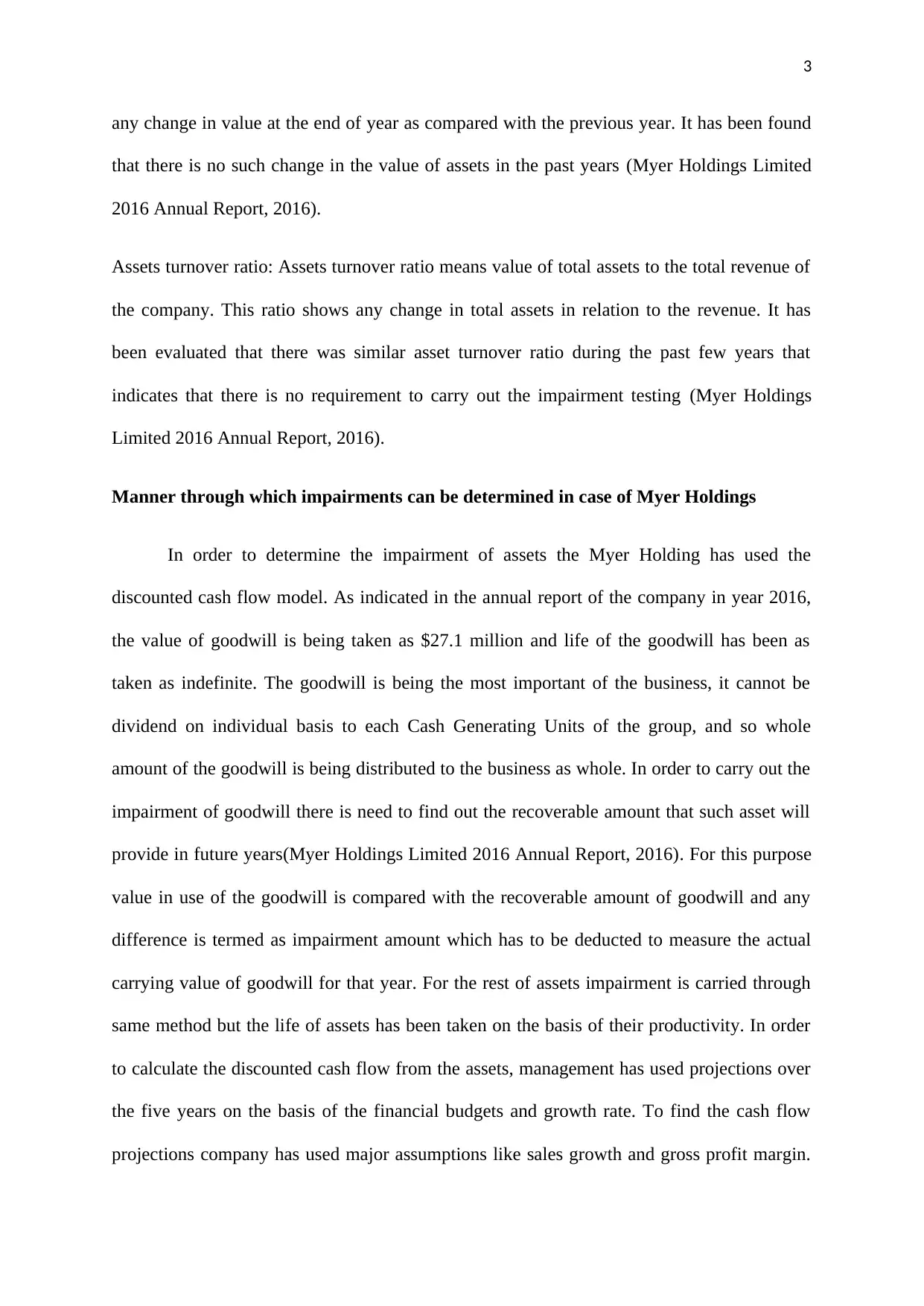
3
any change in value at the end of year as compared with the previous year. It has been found
that there is no such change in the value of assets in the past years (Myer Holdings Limited
2016 Annual Report, 2016).
Assets turnover ratio: Assets turnover ratio means value of total assets to the total revenue of
the company. This ratio shows any change in total assets in relation to the revenue. It has
been evaluated that there was similar asset turnover ratio during the past few years that
indicates that there is no requirement to carry out the impairment testing (Myer Holdings
Limited 2016 Annual Report, 2016).
Manner through which impairments can be determined in case of Myer Holdings
In order to determine the impairment of assets the Myer Holding has used the
discounted cash flow model. As indicated in the annual report of the company in year 2016,
the value of goodwill is being taken as $27.1 million and life of the goodwill has been as
taken as indefinite. The goodwill is being the most important of the business, it cannot be
dividend on individual basis to each Cash Generating Units of the group, and so whole
amount of the goodwill is being distributed to the business as whole. In order to carry out the
impairment of goodwill there is need to find out the recoverable amount that such asset will
provide in future years(Myer Holdings Limited 2016 Annual Report, 2016). For this purpose
value in use of the goodwill is compared with the recoverable amount of goodwill and any
difference is termed as impairment amount which has to be deducted to measure the actual
carrying value of goodwill for that year. For the rest of assets impairment is carried through
same method but the life of assets has been taken on the basis of their productivity. In order
to calculate the discounted cash flow from the assets, management has used projections over
the five years on the basis of the financial budgets and growth rate. To find the cash flow
projections company has used major assumptions like sales growth and gross profit margin.
any change in value at the end of year as compared with the previous year. It has been found
that there is no such change in the value of assets in the past years (Myer Holdings Limited
2016 Annual Report, 2016).
Assets turnover ratio: Assets turnover ratio means value of total assets to the total revenue of
the company. This ratio shows any change in total assets in relation to the revenue. It has
been evaluated that there was similar asset turnover ratio during the past few years that
indicates that there is no requirement to carry out the impairment testing (Myer Holdings
Limited 2016 Annual Report, 2016).
Manner through which impairments can be determined in case of Myer Holdings
In order to determine the impairment of assets the Myer Holding has used the
discounted cash flow model. As indicated in the annual report of the company in year 2016,
the value of goodwill is being taken as $27.1 million and life of the goodwill has been as
taken as indefinite. The goodwill is being the most important of the business, it cannot be
dividend on individual basis to each Cash Generating Units of the group, and so whole
amount of the goodwill is being distributed to the business as whole. In order to carry out the
impairment of goodwill there is need to find out the recoverable amount that such asset will
provide in future years(Myer Holdings Limited 2016 Annual Report, 2016). For this purpose
value in use of the goodwill is compared with the recoverable amount of goodwill and any
difference is termed as impairment amount which has to be deducted to measure the actual
carrying value of goodwill for that year. For the rest of assets impairment is carried through
same method but the life of assets has been taken on the basis of their productivity. In order
to calculate the discounted cash flow from the assets, management has used projections over
the five years on the basis of the financial budgets and growth rate. To find the cash flow
projections company has used major assumptions like sales growth and gross profit margin.
⊘ This is a preview!⊘
Do you want full access?
Subscribe today to unlock all pages.

Trusted by 1+ million students worldwide
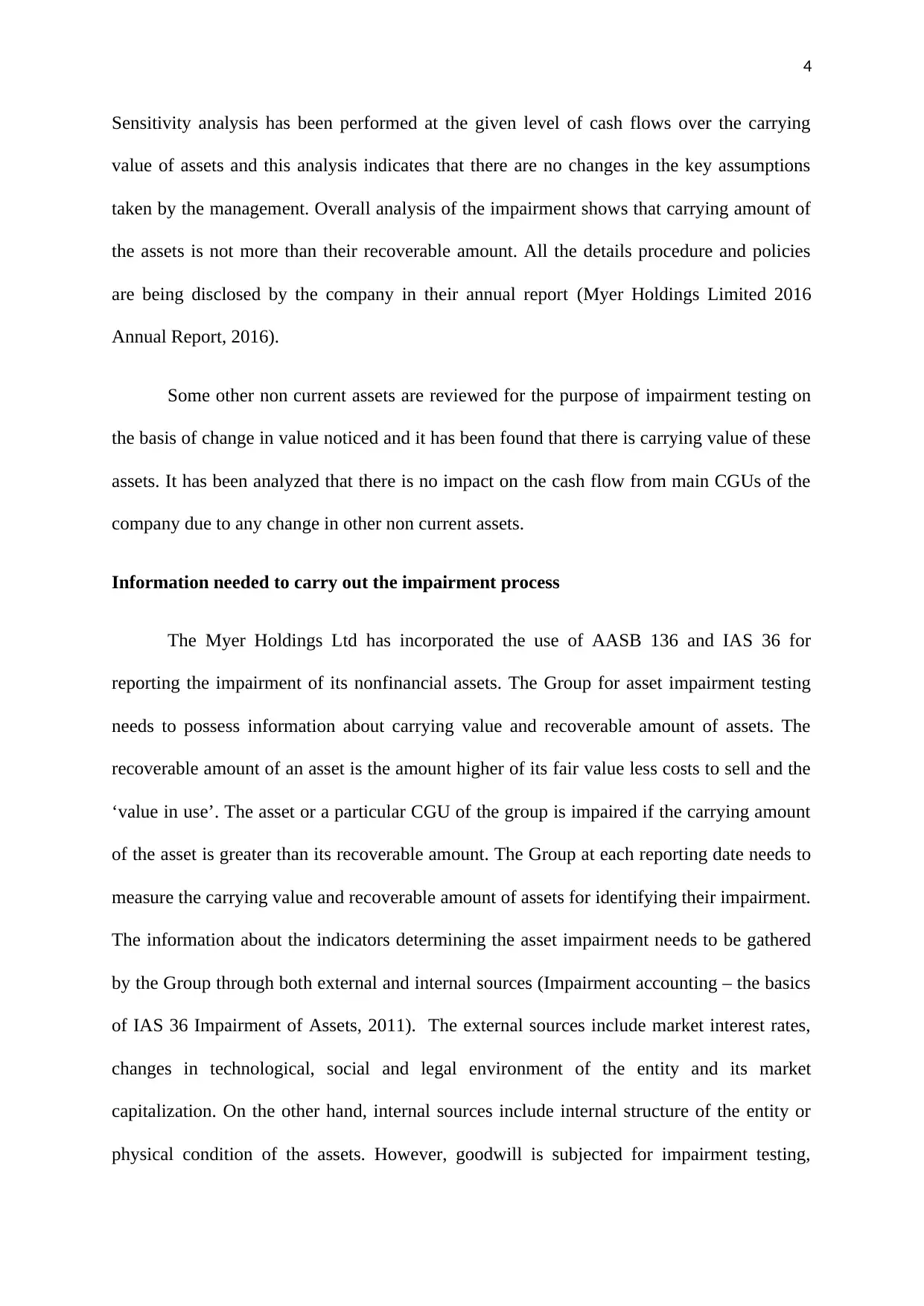
4
Sensitivity analysis has been performed at the given level of cash flows over the carrying
value of assets and this analysis indicates that there are no changes in the key assumptions
taken by the management. Overall analysis of the impairment shows that carrying amount of
the assets is not more than their recoverable amount. All the details procedure and policies
are being disclosed by the company in their annual report (Myer Holdings Limited 2016
Annual Report, 2016).
Some other non current assets are reviewed for the purpose of impairment testing on
the basis of change in value noticed and it has been found that there is carrying value of these
assets. It has been analyzed that there is no impact on the cash flow from main CGUs of the
company due to any change in other non current assets.
Information needed to carry out the impairment process
The Myer Holdings Ltd has incorporated the use of AASB 136 and IAS 36 for
reporting the impairment of its nonfinancial assets. The Group for asset impairment testing
needs to possess information about carrying value and recoverable amount of assets. The
recoverable amount of an asset is the amount higher of its fair value less costs to sell and the
‘value in use’. The asset or a particular CGU of the group is impaired if the carrying amount
of the asset is greater than its recoverable amount. The Group at each reporting date needs to
measure the carrying value and recoverable amount of assets for identifying their impairment.
The information about the indicators determining the asset impairment needs to be gathered
by the Group through both external and internal sources (Impairment accounting – the basics
of IAS 36 Impairment of Assets, 2011). The external sources include market interest rates,
changes in technological, social and legal environment of the entity and its market
capitalization. On the other hand, internal sources include internal structure of the entity or
physical condition of the assets. However, goodwill is subjected for impairment testing,
Sensitivity analysis has been performed at the given level of cash flows over the carrying
value of assets and this analysis indicates that there are no changes in the key assumptions
taken by the management. Overall analysis of the impairment shows that carrying amount of
the assets is not more than their recoverable amount. All the details procedure and policies
are being disclosed by the company in their annual report (Myer Holdings Limited 2016
Annual Report, 2016).
Some other non current assets are reviewed for the purpose of impairment testing on
the basis of change in value noticed and it has been found that there is carrying value of these
assets. It has been analyzed that there is no impact on the cash flow from main CGUs of the
company due to any change in other non current assets.
Information needed to carry out the impairment process
The Myer Holdings Ltd has incorporated the use of AASB 136 and IAS 36 for
reporting the impairment of its nonfinancial assets. The Group for asset impairment testing
needs to possess information about carrying value and recoverable amount of assets. The
recoverable amount of an asset is the amount higher of its fair value less costs to sell and the
‘value in use’. The asset or a particular CGU of the group is impaired if the carrying amount
of the asset is greater than its recoverable amount. The Group at each reporting date needs to
measure the carrying value and recoverable amount of assets for identifying their impairment.
The information about the indicators determining the asset impairment needs to be gathered
by the Group through both external and internal sources (Impairment accounting – the basics
of IAS 36 Impairment of Assets, 2011). The external sources include market interest rates,
changes in technological, social and legal environment of the entity and its market
capitalization. On the other hand, internal sources include internal structure of the entity or
physical condition of the assets. However, goodwill is subjected for impairment testing,
Paraphrase This Document
Need a fresh take? Get an instant paraphrase of this document with our AI Paraphraser
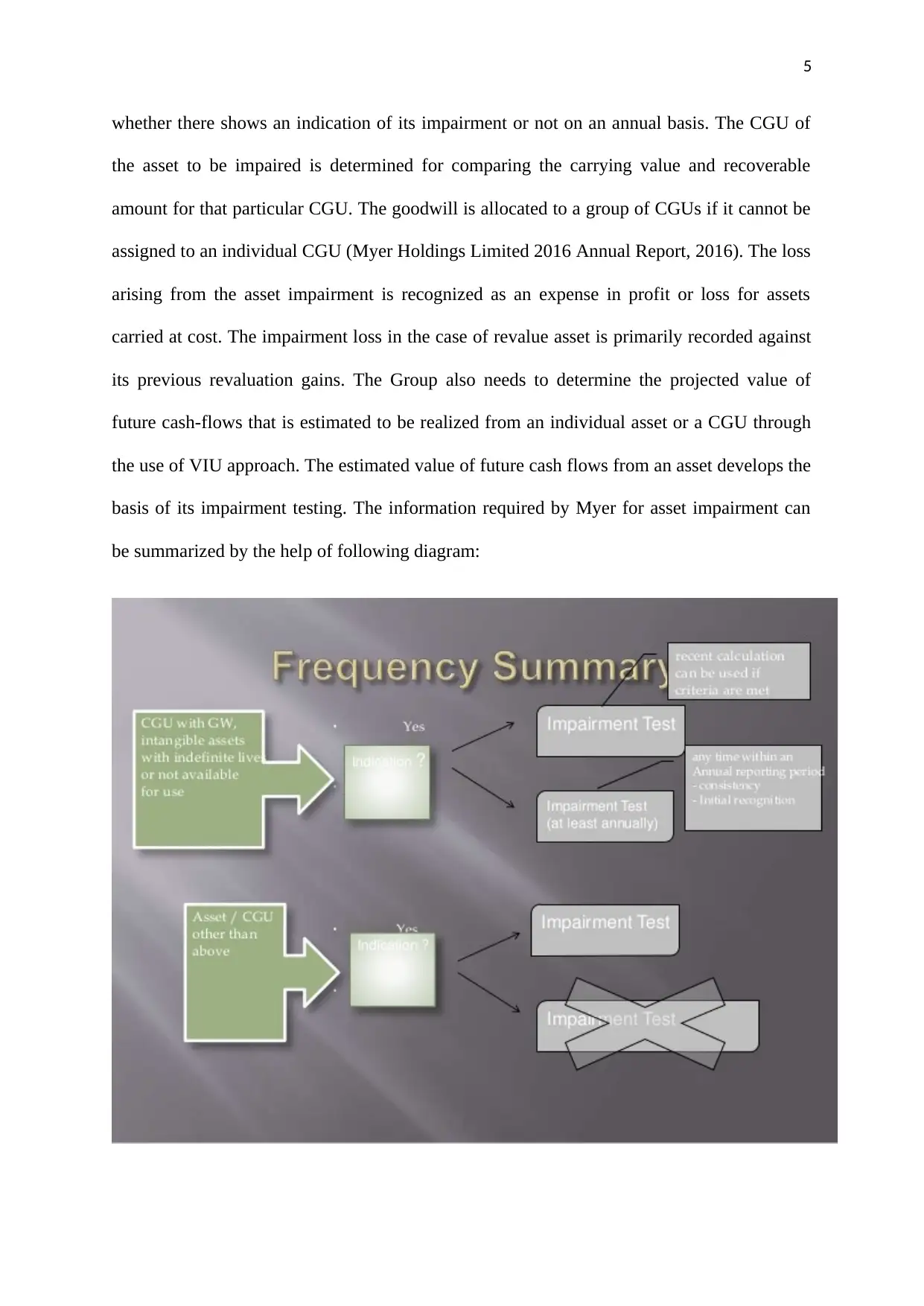
5
whether there shows an indication of its impairment or not on an annual basis. The CGU of
the asset to be impaired is determined for comparing the carrying value and recoverable
amount for that particular CGU. The goodwill is allocated to a group of CGUs if it cannot be
assigned to an individual CGU (Myer Holdings Limited 2016 Annual Report, 2016). The loss
arising from the asset impairment is recognized as an expense in profit or loss for assets
carried at cost. The impairment loss in the case of revalue asset is primarily recorded against
its previous revaluation gains. The Group also needs to determine the projected value of
future cash-flows that is estimated to be realized from an individual asset or a CGU through
the use of VIU approach. The estimated value of future cash flows from an asset develops the
basis of its impairment testing. The information required by Myer for asset impairment can
be summarized by the help of following diagram:
whether there shows an indication of its impairment or not on an annual basis. The CGU of
the asset to be impaired is determined for comparing the carrying value and recoverable
amount for that particular CGU. The goodwill is allocated to a group of CGUs if it cannot be
assigned to an individual CGU (Myer Holdings Limited 2016 Annual Report, 2016). The loss
arising from the asset impairment is recognized as an expense in profit or loss for assets
carried at cost. The impairment loss in the case of revalue asset is primarily recorded against
its previous revaluation gains. The Group also needs to determine the projected value of
future cash-flows that is estimated to be realized from an individual asset or a CGU through
the use of VIU approach. The estimated value of future cash flows from an asset develops the
basis of its impairment testing. The information required by Myer for asset impairment can
be summarized by the help of following diagram:
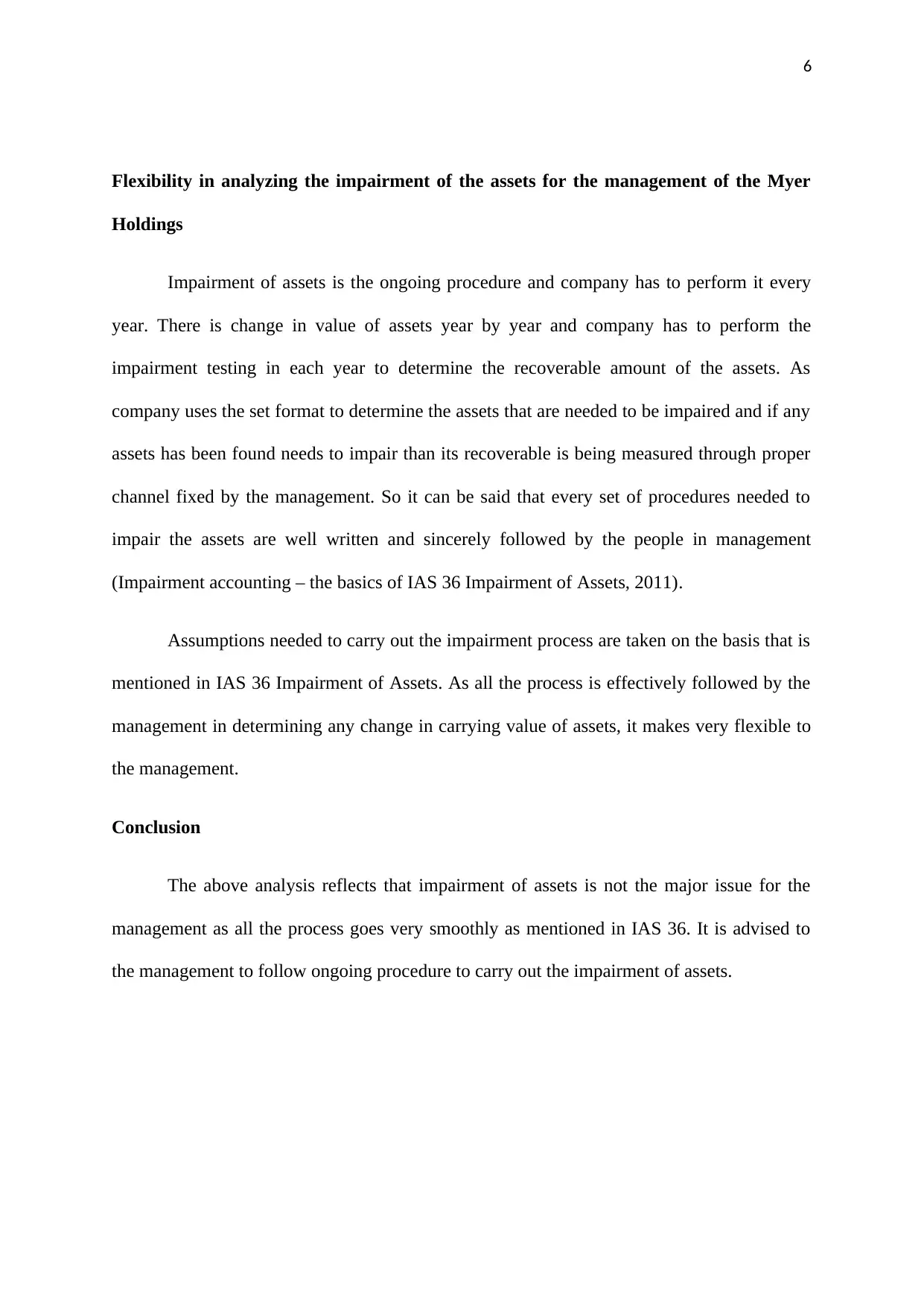
6
Flexibility in analyzing the impairment of the assets for the management of the Myer
Holdings
Impairment of assets is the ongoing procedure and company has to perform it every
year. There is change in value of assets year by year and company has to perform the
impairment testing in each year to determine the recoverable amount of the assets. As
company uses the set format to determine the assets that are needed to be impaired and if any
assets has been found needs to impair than its recoverable is being measured through proper
channel fixed by the management. So it can be said that every set of procedures needed to
impair the assets are well written and sincerely followed by the people in management
(Impairment accounting – the basics of IAS 36 Impairment of Assets, 2011).
Assumptions needed to carry out the impairment process are taken on the basis that is
mentioned in IAS 36 Impairment of Assets. As all the process is effectively followed by the
management in determining any change in carrying value of assets, it makes very flexible to
the management.
Conclusion
The above analysis reflects that impairment of assets is not the major issue for the
management as all the process goes very smoothly as mentioned in IAS 36. It is advised to
the management to follow ongoing procedure to carry out the impairment of assets.
Flexibility in analyzing the impairment of the assets for the management of the Myer
Holdings
Impairment of assets is the ongoing procedure and company has to perform it every
year. There is change in value of assets year by year and company has to perform the
impairment testing in each year to determine the recoverable amount of the assets. As
company uses the set format to determine the assets that are needed to be impaired and if any
assets has been found needs to impair than its recoverable is being measured through proper
channel fixed by the management. So it can be said that every set of procedures needed to
impair the assets are well written and sincerely followed by the people in management
(Impairment accounting – the basics of IAS 36 Impairment of Assets, 2011).
Assumptions needed to carry out the impairment process are taken on the basis that is
mentioned in IAS 36 Impairment of Assets. As all the process is effectively followed by the
management in determining any change in carrying value of assets, it makes very flexible to
the management.
Conclusion
The above analysis reflects that impairment of assets is not the major issue for the
management as all the process goes very smoothly as mentioned in IAS 36. It is advised to
the management to follow ongoing procedure to carry out the impairment of assets.
⊘ This is a preview!⊘
Do you want full access?
Subscribe today to unlock all pages.

Trusted by 1+ million students worldwide
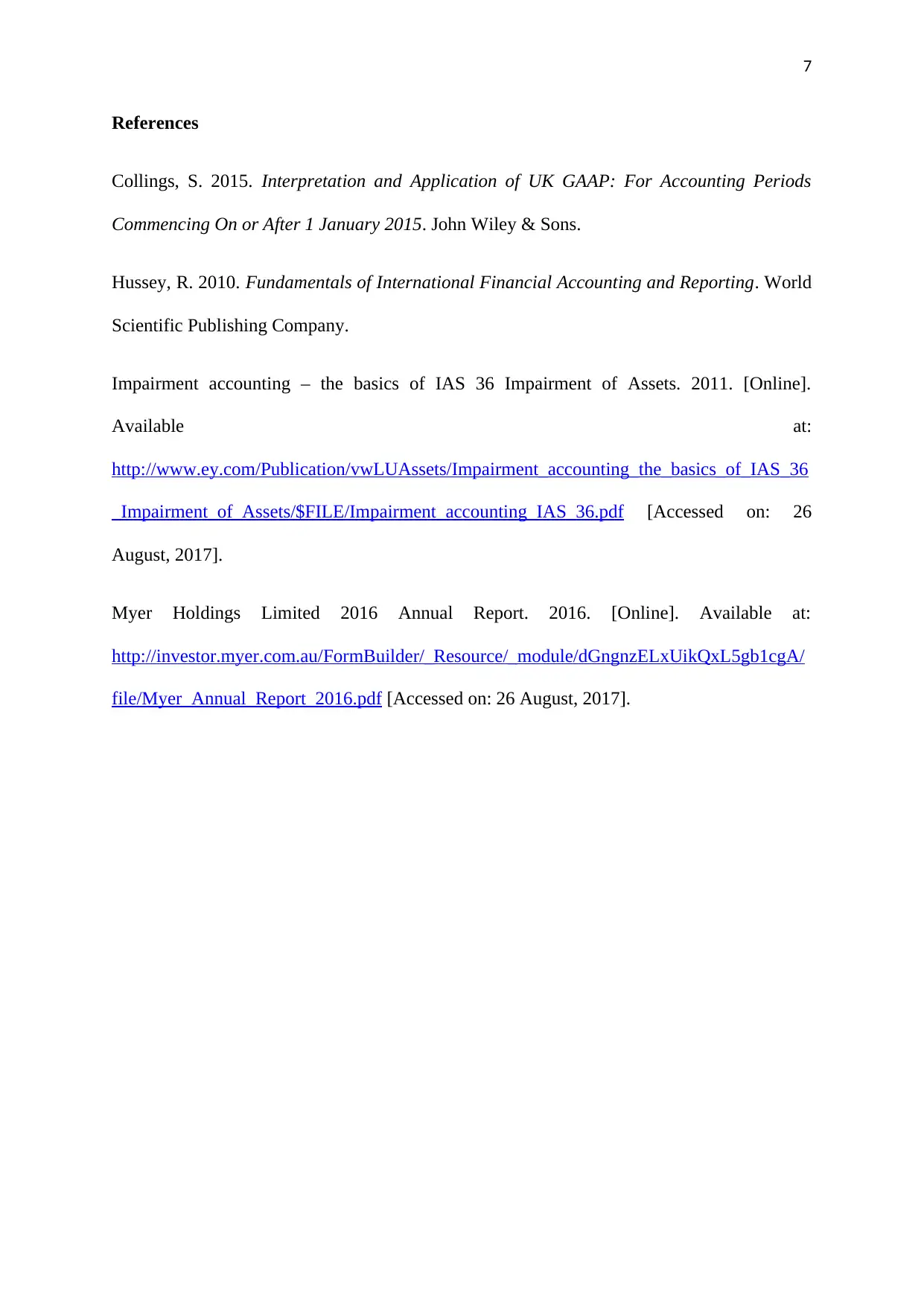
7
References
Collings, S. 2015. Interpretation and Application of UK GAAP: For Accounting Periods
Commencing On or After 1 January 2015. John Wiley & Sons.
Hussey, R. 2010. Fundamentals of International Financial Accounting and Reporting. World
Scientific Publishing Company.
Impairment accounting – the basics of IAS 36 Impairment of Assets. 2011. [Online].
Available at:
http://www.ey.com/Publication/vwLUAssets/Impairment_accounting_the_basics_of_IAS_36
_Impairment_of_Assets/$FILE/Impairment_accounting_IAS_36.pdf [Accessed on: 26
August, 2017].
Myer Holdings Limited 2016 Annual Report. 2016. [Online]. Available at:
http://investor.myer.com.au/FormBuilder/_Resource/_module/dGngnzELxUikQxL5gb1cgA/
file/Myer_Annual_Report_2016.pdf [Accessed on: 26 August, 2017].
References
Collings, S. 2015. Interpretation and Application of UK GAAP: For Accounting Periods
Commencing On or After 1 January 2015. John Wiley & Sons.
Hussey, R. 2010. Fundamentals of International Financial Accounting and Reporting. World
Scientific Publishing Company.
Impairment accounting – the basics of IAS 36 Impairment of Assets. 2011. [Online].
Available at:
http://www.ey.com/Publication/vwLUAssets/Impairment_accounting_the_basics_of_IAS_36
_Impairment_of_Assets/$FILE/Impairment_accounting_IAS_36.pdf [Accessed on: 26
August, 2017].
Myer Holdings Limited 2016 Annual Report. 2016. [Online]. Available at:
http://investor.myer.com.au/FormBuilder/_Resource/_module/dGngnzELxUikQxL5gb1cgA/
file/Myer_Annual_Report_2016.pdf [Accessed on: 26 August, 2017].
1 out of 7
Related Documents
Your All-in-One AI-Powered Toolkit for Academic Success.
+13062052269
info@desklib.com
Available 24*7 on WhatsApp / Email
![[object Object]](/_next/static/media/star-bottom.7253800d.svg)
Unlock your academic potential
Copyright © 2020–2025 A2Z Services. All Rights Reserved. Developed and managed by ZUCOL.





